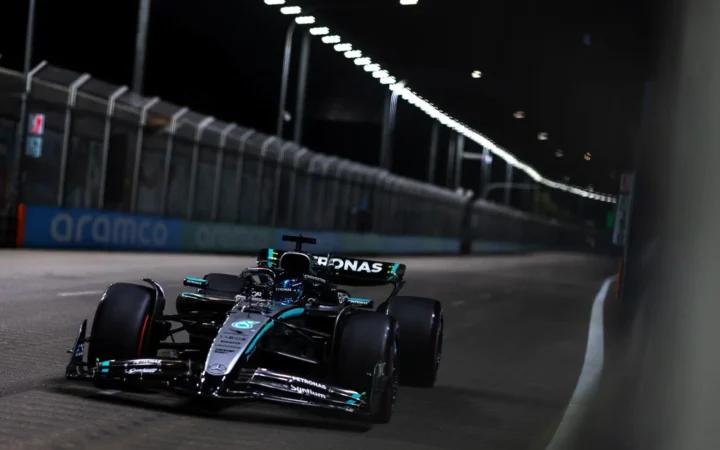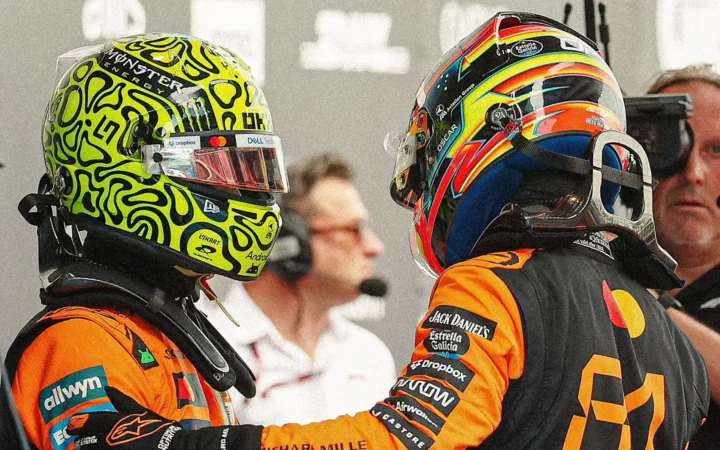Formula 1 history has been made in Singapore this weekend. The FIA has officially declared the 2025 Singapore Grand Prix a ‘heat hazard’ race, the very first time such a designation has been used since the new rule came into effect for the 2025 season.
The ruling was triggered because forecasts predict temperatures above 31 °C in combination with the high humidity of Singapore’s tropical climate. As a result, teams must equip their cars with a cooling vest system, although drivers are not required to use it. The stipulation ensures that those who prefer not to wear the vest cannot gain a weight-saving advantage.
The announcement is a landmark moment, but it is not the first time the cooling vests themselves have been seen in action. Teams have been experimenting with them across the year, fine-tuning the design and reliability before their official race debut.
Mercedes driver George Russell, who also serves as a director of the Grand Prix Drivers’ Association (GPDA), gave his own review after testing the system earlier in Bahrain. “Not everybody finds the top comfortable, but I think some find it more comfortable than others, and of course over time you’ll be able to adjust it to your own preferences.
“But the concept is good, and when you’re racing in 90% humidity and the cockpits are getting on for 60C, it’s a bit of a sauna inside the car, so I think we all welcome it.”
Williams’ Carlos Sainz, another GPDA director, backed the FIA’s call to impose the ruling for Marina Bay. He explained: “Only hot is not too bad for us. We have that, for example, in Hungary where it gets really hot but it’s not humid.
“Humid on its own is not too bad at all if it’s not too hot. But when it’s 28C, 30C degrees plus humid, that’s when it gets to Singapore levels and it’s tough.”
No other circuit on the calendar quite compares with Singapore’s challenge. It is notorious for pushing drivers to their limits: heat, humidity, the bumpy surface of the Marina Bay Street Circuit, and the near two-hour race duration combine to create one of the hardest races in Formula 1.
Why the heat hazard rule exists
The FIA introduced the ‘heat hazard’ regulation in the wake of the brutal 2023 Qatar Grand Prix, when extreme heat and humidity left drivers utterly exhausted. Several required medical treatment, Esteban Ocon admitted he vomited in his helmet mid-race, and Logan Sargeant retired because the physical strain was simply too much.
That incident prompted Formula 1’s leadership to pursue driver cooling solutions more seriously. Although the vests have not yet won unanimous praise, they are steadily improving.
Sainz commented on their development: “Teams are managing to make it work better and better every time we run it. At the beginning, we had it to work more or less for half an hour. Hopefully now the whole system can work at least for an hour.
“It’s a two-hour race. I’ve done it 10 times in Singapore. If it breaks or it doesn’t work, I’m not worried. I’ll do the race and jump out fresh like I always do. But if it works, it’s better, because then you suffer a bit less.”
He added that in Saudi Arabia earlier this year, the system lasted about 15 to 20 minutes.
Aston Martin’s Fernando Alonso also weighed in: “The system works. The shirt itself, the material is a little bit thicker with all the system on it so it is less comfortable. It is a trade-off, it is less comfy when you drive it but it is a little bit cooler.”
How the cooling vests actually function
Inside the cockpit of a modern Formula 1 car, temperatures can easily exceed 40 °C. Drivers are already encased in multiple layers of fireproof Nomex clothing, a balaclava, gloves and a helmet. Overheating has always been a concern, but never before has there been an FIA-regulated solution.
The new system equips the driver with a fireproof vest that contains tubing through which cooled liquid is circulated by a pump. In theory, the system should remain functional for the entire race. In practice, reliability remains variable, and not all teams have been able to run it the full distance.
The drawback is that when the system fails, it can actually worsen conditions. The vest itself acts as insulation, trapping heat, and the liquid inside the tubes can rise above ambient temperature due to the extreme heat generated by the car.
Teams have experimented with different placements for the device and pump, some locating them at the front of the chassis, others beside the cockpit’s side-impact structures, and some even inside the chassis itself.
Russell highlighted one of the more unusual side effects: “The tubes on the front and the back of the vest are connected, and when you go through high-speed corners in the G-force, you’re feeling these tubes on the side of your ribs.
“I think that was definitely an issue for me at the beginning. They made some changes, it has been improved, but as I said, still you have these tubes going around your ribs, which is not the perfect place for it. There’s not many high-speed corners here in Singapore, and high lateral G-forces, so I don’t think it would be a major issue.”
The FIA’s heat hazard ruling in Singapore will go down as an important moment in Formula 1’s continuing battle against extreme conditions. Whether the cooling vests prove transformative or merely a small relief, history will remember the 2025 Singapore Grand Prix as the one where Formula 1 officially drew a line and said: safety, comfort and endurance matter just as much as speed.
Seen in:








